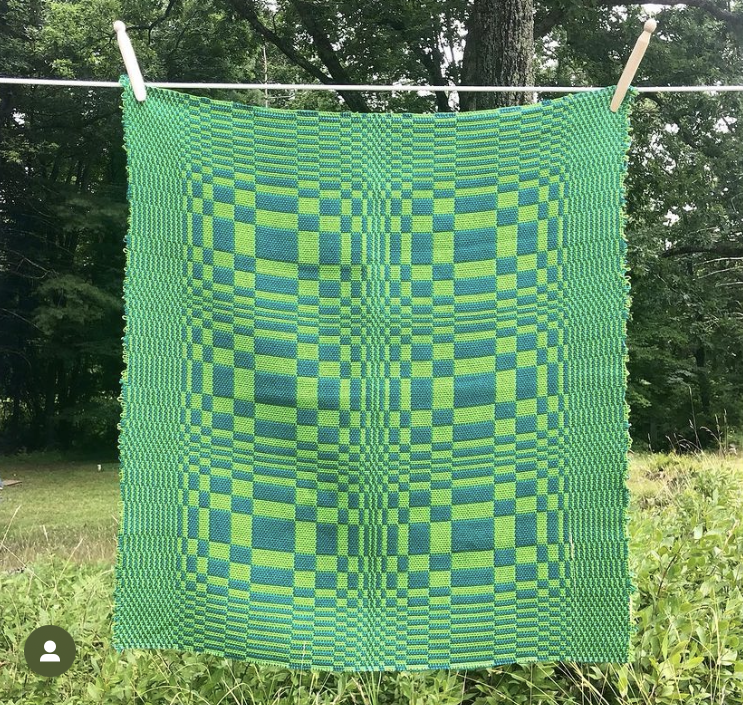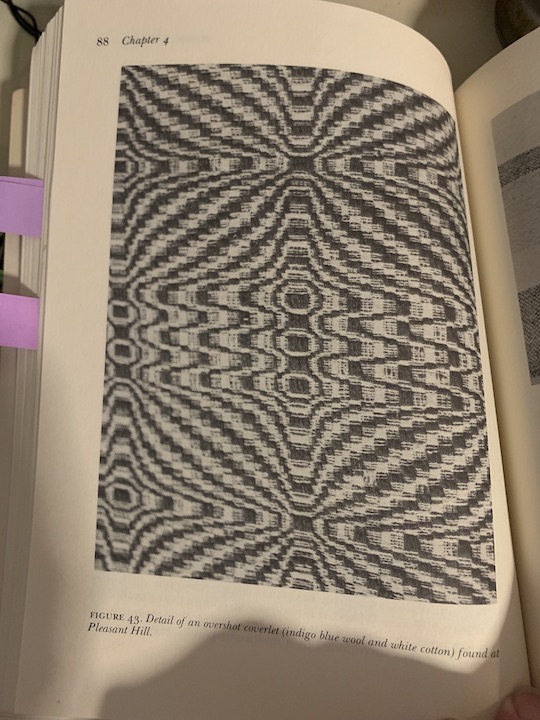~Traditional American COVERLETS / Colonial Era Weaving / SAMANTHA BITTMAN / with a side of . . SHAKER !!
there’s magic – in them, there . . . weavings !!
one of the reasons I’m so attracted to SAMANTHA BITTMAN’s current weavings,
apart from the incredible . . color-ways !!!!
is because they are based on, or more properly: inspired by . . !!
traditional, early American weaving, specifically, utilitarian / bedspread coverlets.
as I repair early American quilts, and completely by hand-stitch by the way; the history and development of early American textile handicraft – is obviously of great interest to me, just as say; Shaker sweater knitting is – to Emily Bode.
Samantha’s weaving style predates Shaker times, and goes all the way back to – colonial times.

SAMANTHA BITTMAN, Large Weaving, ca. 2023
image via Instagram @forelandcatskill / Catskill Weaving School
Samantha’s recent series of loom-based artwork, are . .
“Block Double Weave” in structure, which was used in early American coverlets.”

“detail of an Overshot coverlet. Courtesy RUTH BIGEL ANTIQUES, New York City” /
photo illustration in: ‘The Knopf Collectors’ Guides to American Antiques’, ‘QUILTS, with Coverlets, Rugs & Samplers’, A Borzoi Book / Published by Alfred A. Knopf, Inc / First Printing, 1982.
(in my personal vintage crafts book collection).
above: Above is a traditional Colonial ‘Overshot’ woven coverlet, which was also produced in Colonial times.
here is the brief text / from the ‘The Knopf Collectors’ Guide’:
OVERSHOT WEAVING:
“Made on four-harness looms, Overshot coverlets are among the earliest American woven bedcovers. The name ‘overshot’ describes the weaving technique. The horizontal, or weft, threads were allowed to skip, or ‘overshoot’ three or more vertical, or warp, threads at a time, giving the coverlet a thick but loosely woven appearance . . . The warp threads were generally made of natural, undyed cotton, and the weft of dyed wool. The cotton added strength to the textile while the wool gave warmth. Overshot coverlets made after 1830 used a colored warp as well as multicolored wefts. Patterns usually combine stripes, squares, and diamonds, using a ‘floating’ weft of colored thread over the plain background. Because of the narrow (home) loom frame, (then in use), these coverlets were always made of two pieces, (which were then attached, by being ..) seamed up through the middle.
In the South it was believed that an uneven seam would turn away evil spirits, and insure good luck for the person who used the spread.”
FYI:
that’s something akin to the early (universal & colonial) quilters’ belief . . that an ‘error’ showed the hand of G-d was present in the quilt / if you can’t celebrate a tiny mistake in a patchwork quilt, or it seems, in a hand-woven coverlet, you shouldn’t be a quilter, nor it seems – a weaver / as mistakes happen, on all hand-made items, and you can’t just unravel the whole thing, and start again / it’s too laborious, especially for a utilitarian object / and who knows !!!! / the next piece – might have even bigger mistakes.
plus, it’s also the universal, but especially early American Puritan colonist / crafts persons’ concept of needing humility vs. vain pride / only G-d is perfect. sometimes you will even come upon old patchwork quilts that have an obvious ‘mistakes’, such as an inverted shape, wrong color, or totally ‘off-the-grid’ patch – that was deliberately placed / so as to insure divine presence and a plea for humility. inspiration is bigger – than ‘utilitarian’.
creation is a – lofty endeavor.
and, just because . . . !!
I came across this image – while doing research for the above.
nevermind divine, skilled, and magical / I would call this: ECSTATIC.

“Detail of an overshot coverlet (indigo blue wool and white cotton) found at Pleasant Hill, Shaker Village”.
‘Shaker Textile Arts’, Beverly Gordon, 1983.
Published by the University Press of New England,
with the Cooperation of the Merrimack Valley Textile Museum and Shaker Community, Inc.
Hanover, New Hampshire and London, England.
(in my personal vintage crafts book collection).
